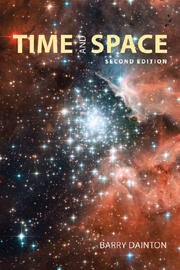Book contents
- Frontmatter
- Contents
- Preface to the second edition
- Preface to the first edition
- 1 Preliminaries
- 2 McTaggart on time's unreality
- 3 The Block universe
- 4 Asymmetries within time
- 5 Tensed time
- 6 Dynamic time
- 7 Time and consciousness
- 8 Time travel
- 9 Conceptions of void
- 10 Space: the classical debate
- 11 Absolute motion
- 12 Motion in spacetime
- 13 Curved space
- 14 Tangible space
- 15 Spatial anti-realism
- 16 Zeno and the continuum I
- 17 Zeno and the continuum II
- 18 Special relativity
- 19 Relativity and reality
- 20 General relativity
- 21 Spacetime metaphysics
- 22 Strings
- Notes
- Glossary
- Web resources
- Bibliography
- Index
8 - Time travel
- Frontmatter
- Contents
- Preface to the second edition
- Preface to the first edition
- 1 Preliminaries
- 2 McTaggart on time's unreality
- 3 The Block universe
- 4 Asymmetries within time
- 5 Tensed time
- 6 Dynamic time
- 7 Time and consciousness
- 8 Time travel
- 9 Conceptions of void
- 10 Space: the classical debate
- 11 Absolute motion
- 12 Motion in spacetime
- 13 Curved space
- 14 Tangible space
- 15 Spatial anti-realism
- 16 Zeno and the continuum I
- 17 Zeno and the continuum II
- 18 Special relativity
- 19 Relativity and reality
- 20 General relativity
- 21 Spacetime metaphysics
- 22 Strings
- Notes
- Glossary
- Web resources
- Bibliography
- Index
Summary
Questions of possibility and paradox
Space offers something that time does not: unconstrained freedom of movement. Up, down, north, south, east, west, and all points in between, not only are we able to move in all spatial directions, but we are free to move back and forth as we wish, and at different speeds. Time is miserly in comparison. As it is by nature one dimensional, it would be churlish to condemn it for offering us only two directions, but the additional constraints it places on us can seem unnecessarily severe. Although we might be said to “travel” into the future simply by persisting, we are condemned to the monotonous rate of a second per second, with no option of skipping over times that we might prefer to avoid; and as for the past, it is utterly out of bounds. There is a sense in which we are captives of time, but not of space; there is no temporal counterpart of the car.
This most basic of differences between the dimensions naturally gives rise to some questions. Is travel through time impossible because of the nature of time? If so, why? One answer is implicit in Bigelow's observation (see §6.7) concerning the rarity of time travel stories prior to the late nineteenth century.
- Type
- Chapter
- Information
- Time and Space , pp. 121 - 144Publisher: Acumen PublishingPrint publication year: 2010



